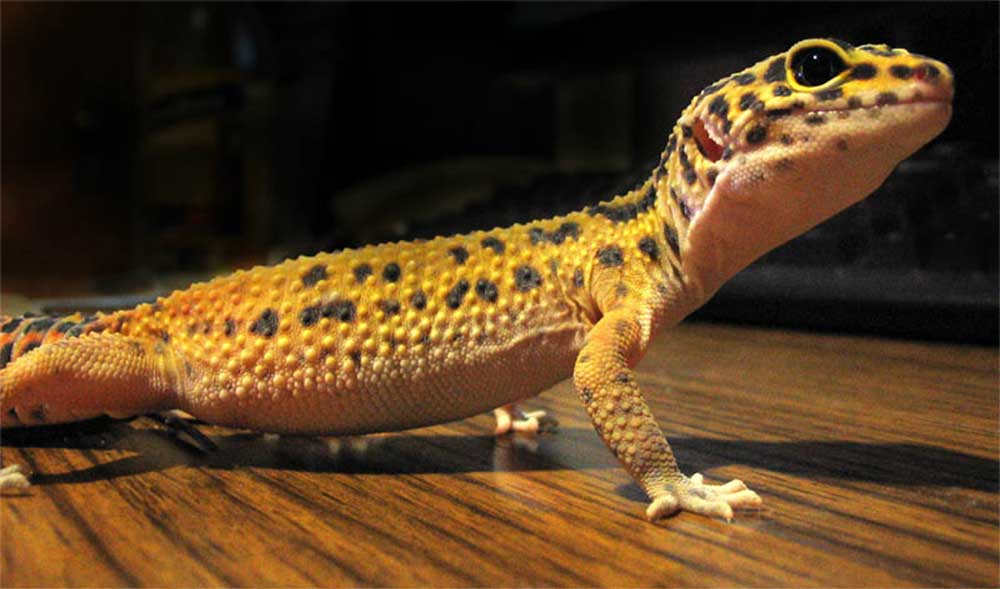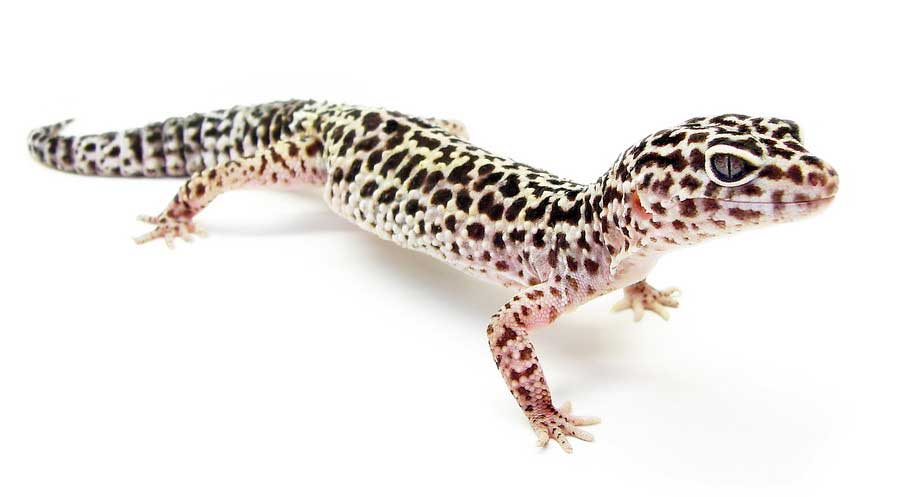
Content |
|---|
Distribution and habitat
The Leopard gecko is originally from eastern Afghanistan, Pakistan and North India. They inhabit rather dry steppe landscapes and grasslands. These crepuscular and nocturnal reptiles spend the day under stones or in burrows that they have dug themselves or have taken from other animals.. At dusk, they like to use the stones that are still hot from the day to warm themselves.
The Leopard gecko is considered a good climber because, Unlike many other species of geckos, does not have adhesive foils on the fingers, but claws. They reach a total length of about 30 centimeters and live up to 20 years.
Summers in the natural range of the Leopard gecko they are hot and humid, with daytime temperatures around 40ºC. Winters are dry and cool, below 20°C during the day. At night there are sometimes temperatures below zero, in the mountains even down to 20°C below zero.
during the cold season, animals hibernate for several months.
Description
The Leopard gecko also shows great variability in nature. The head is about half as long as the trunk.. The eyelids are striking. The snout usually shows an X- or Y-shaped light pattern. The scales are fine grained, with bulging elevations below. The body is usually yellow to grey-violet.. The spots are blackish brown. The segmented tail reaches about a third of the length of the head and torso and, often, still shows the bands of the youth brands. The ventral side is smoothly scaled and unmarked.. Fingers have claws but no sticky plates.
males are more powerful, with broader heads and have pronounced preanal pores. Can you find out the sex of a Leopard gecko observing the anal regions.
Behavior

During the day, the Leopard gecko they shelter from the heat and sunlight in caves, well-heated crevices and burrows. They occasionally bask in the sun for a short period of time, but they only activate at dusk. They choose stones heated by the sun to obtain the heat of their activity, then they go hunting and take refuge in caves to protect themselves from the night cold.
in the terrarium, animals change residence several times. At bedtime (during the day) prefer heated caves and crevices, which must offer a maximum of 27°C. They switch between wet areas, dry, lighter or darker. Especially for egg laying and moulting, well-moistened areas should be offered. This is easily achieved by using a wet box, which can be made decoratively to match the design of the terrarium.
The Leopard gecko They need a place to relieve themselves.. Us, we determine which place in the terrarium is suitable. From then on, droppings are always deposited in the same place.
The Leopard gecko are in dire need of protection, are reluctant to move through open spaces. They prefer to cover themselves from at least 3 sides (soil, rear wall and from above).
In case of danger, The Leopard gecko they can release their tail fully or partially (so-called default breakpoints). This severed piece continues to squirm like a worm and distracts the attacker from their true prey.. Terrarium keepers should never grab an animal by the tail.
The Leopard gecko they are good to keep them in groups, but you should never socialize 2 males. A male can share a terrarium with 2-4 females, it just needs to be the right size.
Leopard Gecko in captivity
Life expectancy
The Leopard gecko they can become proverbially old if maintained in a manner appropriate to the species. In this case, 20 years are considered normal. In the news, almost been verified 30 years in literature.
Terrarium
For a group of 1,2 Geckos, the minimum dimensions of 100 long x 50 wide x 50 high have proven to be adequate. You should not choose the smallest, the largest is gladly accepted.
If the group consists of 4 animals, should aspire to 120 long x 60-80 wide x 60-80 High.
The substrate should consist of a mixture of sand and clay, that makes it suitable for excavation. Soft sand is avoided by animals. It is a mistake to think that the sand is eaten on principle, what causes a bowel obstruction. Healthy animals can also ingest sand, which is not necessarily harmful.
Building
The terrarium can be glass, wood, Styrodur, acrylic or similar materials.
Back walls can be Styropur, construction foam, adhesive for tiles or natural materials.
Crush holes in the rear walls look mandatory. But, taking into account their way of life, more attention should be paid to substrate design.
The substrate must be rich in cracks, caves and passageways. In this way, different microclimatic zones can be offered. Substrate may be tiled or otherwise protected from moisture, but a cana steppe must be designed above.
ventilation slots
They must always be at odds, that is to say, at the front under the glass panes and at the top of the rear wall or on the terrarium lid.
Decor
- Stones taken from nature or trade, according to taste and color combination.
- Roots taken from nature or from a specialized store.
Illumination
– Basic lighting should be fluorescent tubes (LSR) during 12-14 hours a day to simulate a day. In this case, simple light bars with a daylight spectrum are enough.
– late afternoon, for example between 16 and 20 hours, a foco BY 38 of 50 watts, or a little more, can heat a root, a rocky outcrop, a stone or similar structure.
– UV light is considered controversial, animals are active at dusk, so ultraviolet light is unnecessary.
– Heating stones or heating mats are also controversial, but they can be very useful to provide a warm surface at night, similar to rocks heated by the sun in nature.
– Heating stones or mats should never be buried in the substrate. Rather they should be integrated above the substrate, like the rocks in nature.
– The operating time of these “hot stones” is reasonable of 16 to 22 hours, after which it should be cooled in the terrarium.
– Night lighting should be refused for this species, because it goes against his nature.
Diet
- There are crickets on the menu, various cockroaches, crickets, grasshopper, zophobas larvae and mealworms, centipede, worms, beetles, spiders, scorpions, as well as mammals and young birds that nest.
- These Geckos they are hunters who are attuned to a certain range of movements of their prey, so they should also actively hunt whenever possible in the terrarium and not passively wait for them to feed.
- A varied diet is recommended, more than a lot, to avoid overfeeding.
- This variety is easier to come by if small foods are chosen rather than a single large one..
- Insects from specialized stores can be used as food, their own brood and prairie plankton.
- Adult animals only need to be fed a variety of small insects once a week in the terrarium.
- Young animals should be given food every day for breeding, reduced according to development progress.
- Care must be taken to ensure optimal supplementation.
- – The insects, if not the plankton of the prairie, should also be well fed before feeding. This is called a good charge.
- It also, the terrarium should not lack a supply of calcium. It is useful to distribute cuttlefish bone or ground shell gravel on the rock walls, since animals like to explore their territory by licking. A small bowl filled with calcium flour is also helpful.
- Of course, there should always be a small bowl of water.
- As animals tend to quickly lose their shyness towards humans, they will eat from the tweezers or even from the hand of the keeper. This should not tempt you to train them, so to speak, because active hunting at the right time keeps them healthier in the long run than begging for food.
Reproduction
Females usually lay 2 eggs each, sometimes only one. It is quite common for there to be 4-5 put per year, and have a few 4 weeks between two sets. We incubate the eggs between 26 y 28°C. The young hatch after a few 7-8 weeks.
It is interesting to note that young animals are extremely aggressive at first, but completely harmless. This protection mechanism disappears after a few weeks. The juvenile coloration in the form of horizontal stripes is maintained for about 4-6 months, then the animals slowly change color and after a few 10-12 months have the appearance of an adult animal. The completion of the color change is a clear signal of the beginning of sexual maturity.. The rearing of young animals does not present any problem.. They are raised separately from the adults. Price of a
price of a leopard gecko
The price of a Leopard gecko in the exotic animal market ranges from 50 – 60 EUR.
Alternative names:
1. Common leopard gecko (English).
2. Eublepharis macularius (French).
3. Pakistanische Fettschwanzgecko (German).
4. Osga-leopardo, Geco-leopardo (Portuguese).
5. Gecko Leopardo Asiático, (español).
